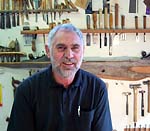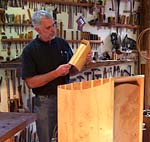Having the opportunity as a youngster to spend my summers in the forests and lakes of Northern Michigan I'm sure has affected what I'm doing right now. I remember being in the forest and playing with sticks, assembling them, and liking the feeling of being with the trees.
Wood designer-maker Kevin Perkins

I was born in Tasmania. My father was in the timber industry so I was always surrounded by stories of timber and things like that. I left school at 14 to do a trade in joinery. Prior to that I was more interested in making boats.
I didn't really get to furniture until I finished my trade in carpentry and joinery. I did some post-trade in building and art, concentrating on sculpture.

When I did my trade there was never any understanding about the real trees. We knew what the timber was dead, not alive. It became a real interest for me to pursue – to identify the leaves and what shade of green is that and what does that produce in timber terms. Having taught since, I've seen a lot of Tasmanians and mainlanders really enjoy that part – learning about our forest and taking some sort of ownership.
Tasmania does offer a lot of opportunities. I mean it has isolation, which can bring disadvantages, but I think our big pantry of timbers is wonderful for anyone who is really interested in pursuing timber as a means of expression.
A lot of what I do revolves around Tasmanian issues. We have a rich diversity of wildlife and a lot of my recent cabinets have been dealing with things that are threatened or extinct or possibly extinct. For example, in my thylacine cabinet, the inside of the cabinet shows rare raindrop timbers which could be the inside of the carcass of an animal. The outside is using tiger grain myrtle which is in the early stage of decay. It's a rich red timber with black fungal markings which actually look like tiger stripes.
I'm very passionate about the fact that the way forestry is happening is not the correct way and I'm not in favour of the green thing. I admire Bob Brown (the leader of the Green Party) but I think to close up our old growth forests to people who have traditionally had access to them like boat builders is wrong.
Traditionally the forests in Tasmania were used in a sustainable way. They did selective logging. What wasn't a mature tree was left, and it became available later on. The current practice is the woodchip-driven practice - everything goes, everything is cut at the face, whether it's one year or 250 years old. When woodchips are only worth $7 a ton, it seems such a shame, that we have such grand old-growth timbers and we're just flogging them off for bugger all.
There was a German philosopher who had this wonderful thought. That if we are felling a tree, we use that tree to make something in a sensible way so that the item lasts for as long as it takes for the tree to replace itself. So in the case of Huon pine, you would have to make and design for 1000 years. Otherwise you're not doing it justice. Whereas with plantation radiata or eucalypt, you're only looking at the 15, 20 year mark. I'm for the old growth, where you do things for the long term and do things of quality.
Related
I'm a self-taught wood turner. That didn't satisfy me in some way, there was something missing. So I toddled off to the Canberra School of Art and spent a couple of years there doing a furniture-based wood course.
I turned to furniture mid-career. I was actually trained as a musician and a high school teacher and I decided to do something else. I'd done a lot of building before and I suddenly decided to build stuff that I was going to sell instead of keep.
About fifteen years ago I bought a little house that I was going to renovate but I could never find anyone to do things exactly as I wanted them.
I was born in Melbourne and I've been in Tasmania for about 14 years. I like Tasmania because I like the bush, I like the weather, I like the timber. It's a much more natural environment than the mainland. The landscape here is inspirational to my work.
My workshop is on part of the family farm and I've lived alongside it or near it all my life apart from the occasions where I've been studying or working overseas or interstate.
I came to Australia in 1970 to take up a teaching position at the Tasmanian School of Art. We were probably some of the last of the Ten Pound Poms. I was very keen after going through college in the UK to travel overseas and try other cultures.
I remember carving when I was about 8. I used to steal my mum's lino carving tools. I was able to go down to the workshop in the garage and carve away. I think the first thing I came up with was an acanthus leaf. I was really pleased with that.








